Understanding homicide statistics in Montreal: Key data and insights you need to know
- Key Insights
- Demographics of homicide victims in Montreal
- Causes and motives behind homicides in Montreal
- Homicide investigation and law enforcement in Montreal
- Impact of homicide on Montreal communitie
- Trends in homicide rates over time in Montreal
- Efforts to prevent homicide in Montreal
- Resources for homicide victims’ families and communities in Montreal
- References
Key Insights
| According to CTV News, Montreal’s homicide rate dropped by 20.5% in 2023, with 54 cases compared to 55 in 2022. On a nationwide scale, Canada saw a 14% decline in homicides. According to the Government of Canada, Indigenous people accounted for 24% of homicide victims in 2017, with a homicide rate 6x higher than non-Indigenous people. As per Statistics Canada, firearms were used in 40% of homicides in 2021, with nearly half linked to gang activity. Homicides in Canada peaked at 882 in 202 before dropping to 778 in 2023, though rates remain higher than pre-2020 levels, according to Statistics Canada. |
According to CTV News, homicides in Montreal showed a significant decline in 2023, with a 20.5% drop compared to the previous year.
The city recorded 54 homicides, which is down from 55 in 2022. This results in a lower homicide rate of 1.19 per 100.000 people.
Montreal’s decline aligns with the overall national decrease of 14% in homicide cases. Canada recorded 778 homicides in 2023, which is 104 fewer victims than in 2023.
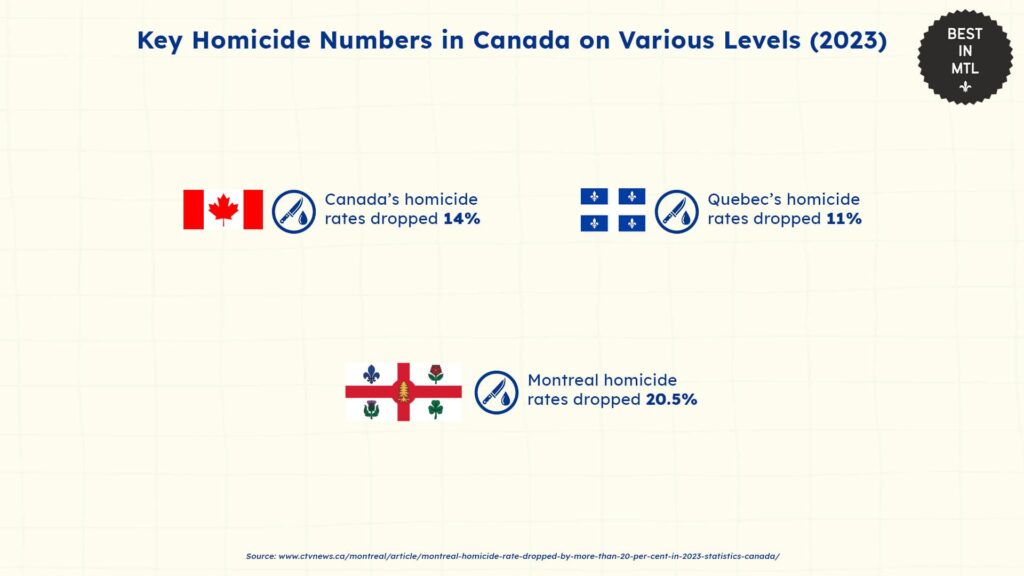
In terms of provincial comparisons, Quebec had one of the lowest homicide rates in the country in 2023, ranking 3rd overall at 1.14 per 100,000 people. This marks an 11% decrease from the previous year.
The drop in homicide rates in Montreal, as well as at the national and provincial levels, is an encouraging sign. However, it remains imperative to follow through with crime prevention to sustain the decline.
Demographics of homicide victims in Montreal
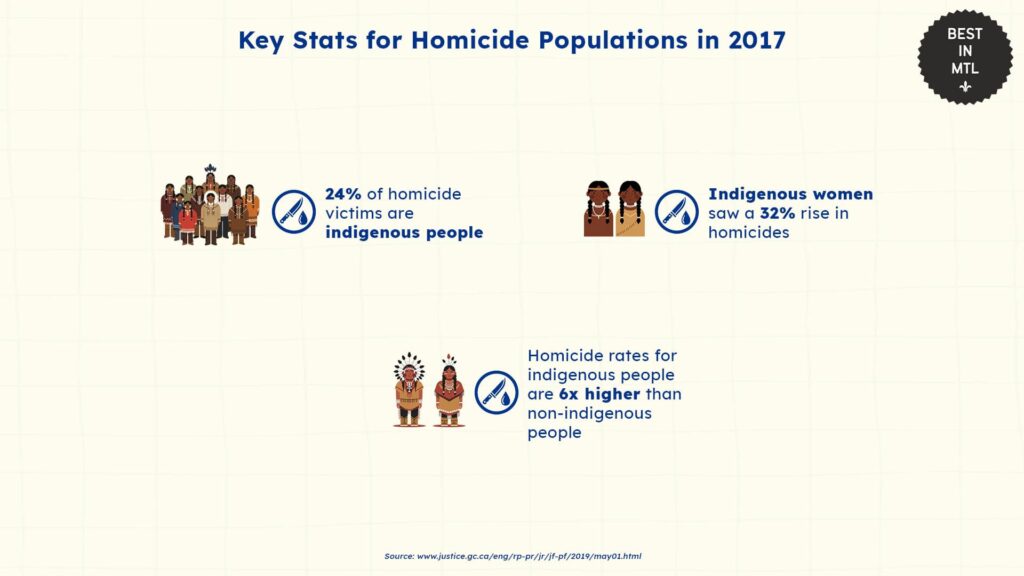
While there aren’t specific data on homicide victims in Montreal, looking into national numbers provides insights into the demographics of victims on a national scale.
According to the Government of Canada, while Indigenous individuals make up only 4.9% of the Canadian population, they accounted for 24% of all homicide victims in 2017.
For comparison, the homicide rate for Indigenous people was higher than for non-Indigenous individuals, at 8.76 per 100,000 people. This is 6 times the rate of non-Indigenous individuals.
Indigenous women, in particular, experienced a sharp rise in homicide rates with a 32% increase or 4.22 per 100,000 indigenous women. This marks a continuous upward trend since 2014.
Causes and motives behind homicides in Montreal
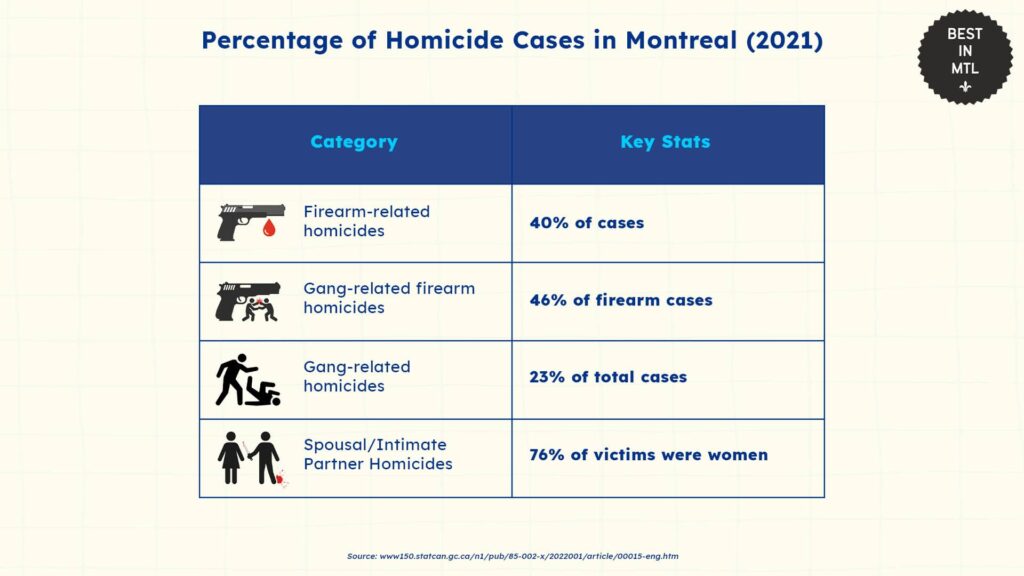
To understand the causes and motives behind suicide, it’s important to look into national statistics.
As per Statistics Canada, firearm-related violence continues to be a significant factor in homicide cases across the country. In 2021, 40% of homicide victims nationwide were killed by a firearm.
Notably, 46% of these firearm-related homicides were linked to gang activity.
Gang-related homicides have been particularly concerning, accounting for 23% of all homicides in Canada in 2021. This makes it the highest recorded rate of gang-related homicides since national data collection began in 2005.
Beyond gang violence, domestic homicides represent another critical factor. Women are disproportionately affected, as they are 7 times more likely than men to be killed by a spouse or an intimate partner.
In fact, 76% of all spousal and intimate partner homicide victims in Canada in 2021 were women.
Motives behind homicides in Montreal
As for the motives, Statistics Canada noted that emotions such as frustration, anger, or despair are frequently cited as primary drivers.
In 2021, nearly 39% of homicides committed by female perpetrators were motivated by these emotions. An additional 33% of these cases were linked to arguments or quarrels.
When examining methods used in gender-related homicides, 44% of cases committed by female perpetrators involved stabbing as the cause of death.
In contrast, firearms tend to be more prevalent in cases involving male perpetrators. Strangulation, suffocation, or drowning were the second most common methods at 21%.
This is followed by beatings at 18%.
Homicide investigation and law enforcement in Montreal
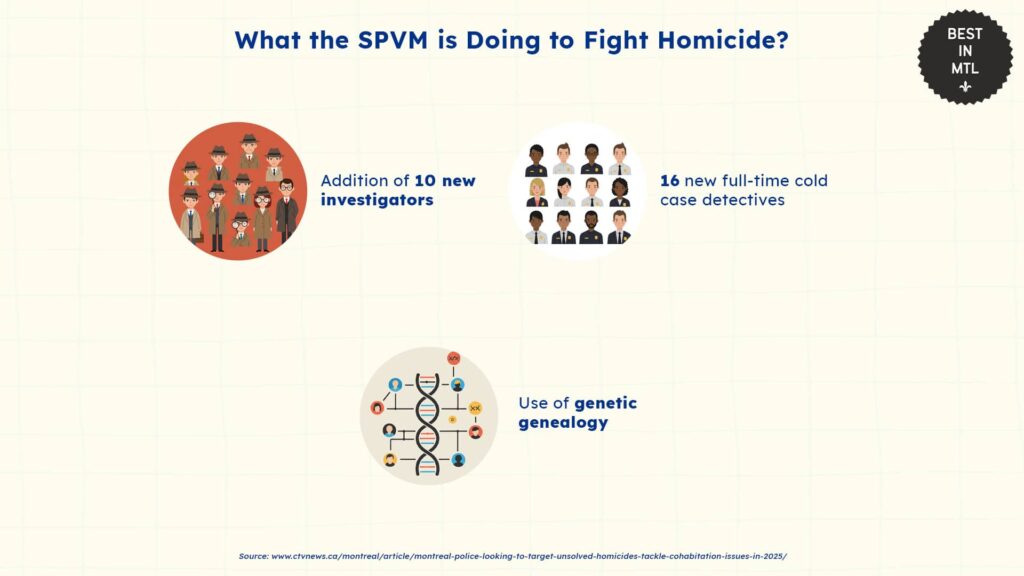
According to CTV News, homicide investigations and law enforcement remain key priorities for the Montreal police (SPVM) in 2025.
To enhance homicide resolution rates, the SPVM has announced the addition of 10 new investigators. In 2024, they made arrests in 26 homicide cases, resulting in a resolution rate of 81%.
In addition to this, CBC reports that the SPVM is pushing to solve cold case homicides. With more than 800 unsolved cases on file, the SPVM is expanding its cold case unit, with now 16 full-time detectives dedicated exclusively to cold cases.
A key component of this initiative is the use of advanced forensic technology, particularly genetic genealogy. This relies on broad DNA databases to identify suspects’ relatives, which can be instrumental to solving cold cases.
Impact of homicide on Montreal communitie
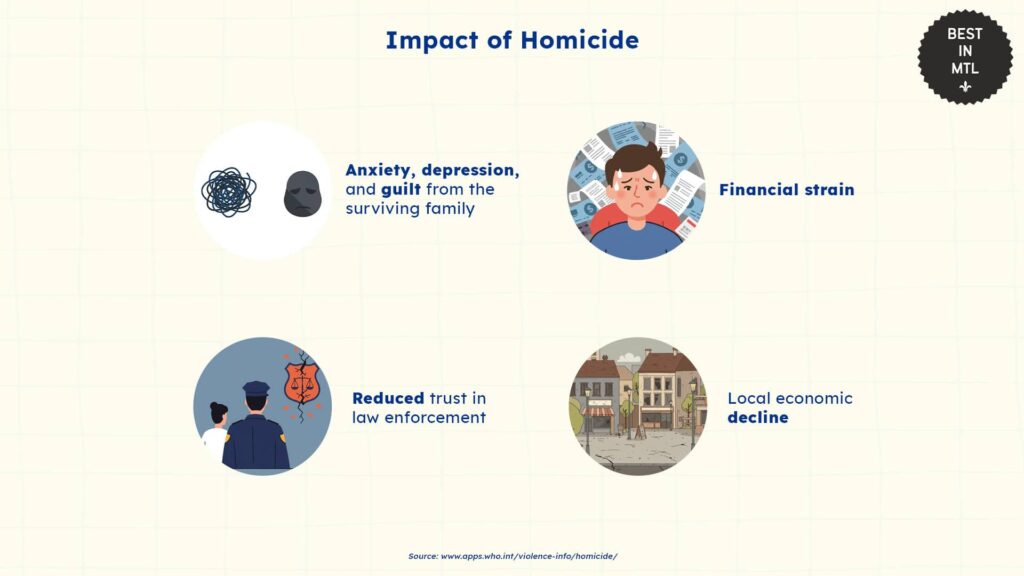
The impact of homicide on Montreal communities and individuals is a universal consequence. In general, around the globe, the World Health Organization names the impact of homicides:
- Psychological Impact on Family Members: Surviving family members often experience anxiety, depression, PTSD< and feelings of guilt or aggression.
- Financial and Socio-economic Consequences: Families may face financial strain due to funeral costs, legal fees, and the loss of a primary breadwinner.
- Community Fear: Rising homicide rates can lead to a sense of insecurity, discouraging community engagement and trust in law enforcement.
- Impact on Local Economy: Areas with frequent homicides may suffer from economic and social decline. Businesses may struggle, property values may drop, and community activities may decrease.
Trends in homicide rates over time in Montreal
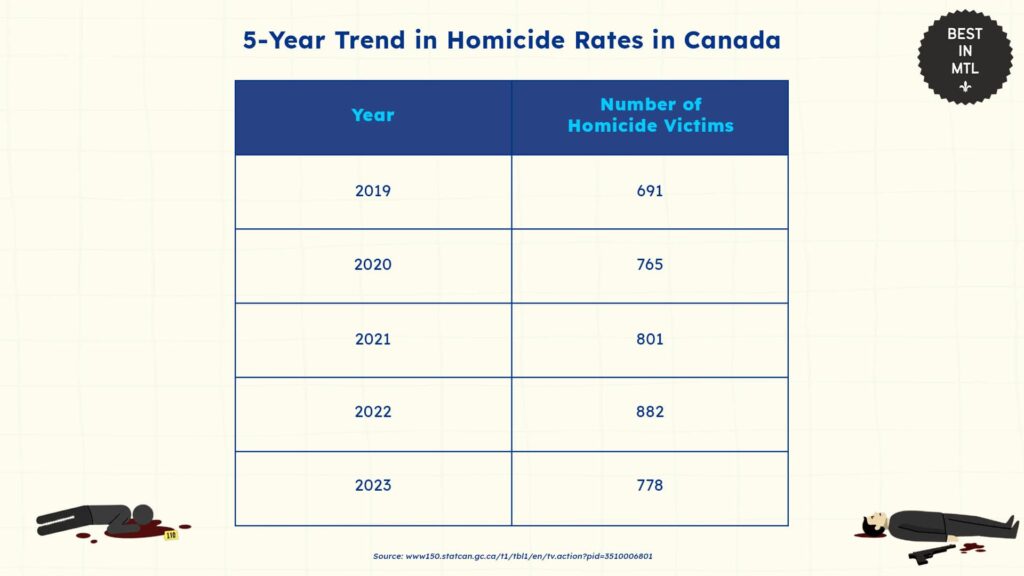
According to Statistics Canada, homicide rates in the country have fluctuated over the past five years, reflecting a similar trend in Montreal.
In 2019, there were 691 homicide victims nationwide. By 2020, homicides had risen to 765, marking a significant trend.
The upward trend continued in 2021, with the number of homicide victims reaching 801. And in 2022, homicides peaked with 882 victims, the highest in the five-year span.
By 2023, the number of homicide victims declined to 778. However, the rate remained higher than pre-2020 levels.
Efforts to prevent homicide in Montreal
As per the Government of Montreal, the city has campaigns in place to make the city safer despite not having specific initiatives against homicides.
This is made possible through the Montreal Model for a Safe City initiative.
A key objective of this model is to make public spaces safer. This is achieved through targeted interventions, such as the RENFORT hotline and specialised teams like the Mobile Social Meditation and Intervention Team (EMMIS).
Collaboration between different sectors is also emphasised in the fight against homicide and urban violence. The Comité Stratégique en Sécurité Urbaine de Montréal (CoSSUM) brings together public health agencies and social services to ensure a unified response to crime.
Resources for homicide victims’ families and communities in Montreal
On a nationwide scale, the Canadian Resource Centre for Victims of Crime (CRCVC) plays a significant role in providing assistance to survivors of serious crimes.
One of the key aspects of CRVCVC’s work is empowering victims to regain control of their lives. Through bilingual advocacy, research, and education, the CRCVC helps survivors understand their options, access resources, and connect with the right systems.
On a provincial scale, the Quebec Ministry of Justice provides assistance through the Crime Victims Assistance Fund (FAVAC) to ensure victims receive essential services.
According to the Government of Canada, Quebec’s legal framework ensures that victims’ rights are recognised. This mobilizes various programs and organizations such as the Bureau d’aide aux victimes d’actes criminels (BAVAC) and Crime Victim Assistance Centres (CAVAC).
CAVAC, in particular, provides essential services such as legal information, emotional support, and assistance with victim impact statements. They also assist with restitution claims, ensuring victims and their families receive financial compensation for expenses related to the crime.
References
- Canadian Resource Centre for Victms of Crime. CRCVC (n.d.). https://crcvc.ca/
- CBC. With 800 unsolved homicides, Montreal’s police force is bolstering its cold case unit (2025). https://www.cbc.ca/news/canada/montreal/montreal-police-cold-case-unit-1.7456414
- CTV News. Montreal homicide rate dropped by more than 20 per cent in 2023: Statistics Canada (2024). https://www.ctvnews.ca/montreal/article/montreal-homicide-rate-dropped-by-more-than-20-per-cent-in-2023-statistics-canada/
- CTV News. Montreal police looking to target unsolved homicides, tackle cohabitation issues in 2025 (2025). https://www.ctvnews.ca/montreal/article/montreal-police-looking-to-target-unsolved-homicides-tackle-cohabitation-issues-in-2025/
- Government of Canada. Victim Services in the Provinces and Territories (n.d.). https://www.justice.gc.ca/eng/rp-pr/jr/vsc-savc/servicespt.html
- Government of Montreal. Preventing violence: The Montréal model (2024). https://montreal.ca/en/articles/preventing-violence-montreal-model-61407
- Statistics Canada. Homicide in Canada, 2021 (2022). https://www150.statcan.gc.ca/n1/pub/85-002-x/2022001/article/00015-eng.htm
- Statistics Canada. Gender-related homicide of women and girls in Canada (2023). https://www150.statcan.gc.ca/n1/pub/85-002-x/2023001/article/00003-eng.htm
- Statistics Canada. Number, rate and percentage changes in rates of homicide victims1, 2, 3, 4 (n.d.). https://www150.statcan.gc.ca/t1/tbl1/en/tv.action?pid=3510006801
- WHO. Homicide WHO Global Health Estimates (2019 update) (n.d.). https://apps.who.int/violence-info/homicide/













